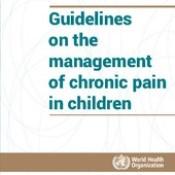
In December 2020, the World Health Organization (WHO) published its “Guidelines on the management of chronic pain in children.” The WHO guidelines contain exciting news for Acceptance and Commitment Therapy researchers and practitioners: ACT is specifically recommended for use. The guidelines state there is “moderate certainty evidence" in support of ACT in improving functional disability. Cognitive behavioural therapy and related interventions (acceptance and commitment therapy, behavioural therapy and relaxation therapy) received the strongest recommendations in the report, exceeding even medications.
According to the guidelines: "In children with chronic pain, psychological management through cognitive behavioural therapy and related interventions (acceptance and commitment therapy, behavioural therapy and relaxation therapy) may be used (conditional recommendation, moderate certainty evidence)" (page 10). The report adds that it does not appear to matter whether psychological therapy is delivered face-to-face, remotely, or using a combined approach. Although the phrase “conditional recommendation, moderate certainty evidence” in support of ACT and related methods may seem unenthusiastic, it should be noted that of the four formal recommendations made in the report covering physical treatments, medications, and psychological treatments including ACT, only the evidence for psychological treatment reached that level of certainty.
ACT’s new status in the WHO “Guidelines on the management of chronic pain in children” represents the culmination of two decades of ACT research on pain.
Click here to read the full WHO guidelines
From the WHO website:
In these guidelines, the World Health Organization (WHO) provides evidence-informed recommendations for the management of chronic pain in children. The recommendations are based on the most current, high-quality scientific evidence, and were formulated following processes and using methods that meet the highest international standards for guideline development. The recommendations in this guideline are based on systematic reviews of the evidence on benefits, harms, acceptability and feasibility, as well as on equity and resource considerations. The recommendations were formulated by the Guideline Development Group, consisting of individuals with diverse expertise and experiences and with global representation.
The purpose of this guideline is to assist WHO Member States and their partners in developing and implementing national and local policies, regulations, pain management protocols and best practices. It will help countries balance concerns about ensuring access to appropriate therapies for pain relief with the harms arising from misuse of medications and other potential adverse effects of interventions for pain management.
These guidelines focus on physical, psychological and pharmacological interventions for the management of primary and secondary chronic pain in children 0 to 19 years of age.
Recommendations (“Guidelines on the management of chronic pain in children” Page 10):
- In children with chronic pain, physical therapies may be used, either alone or in combination with other treatments (conditional recommendation, very low certainty evidence).
-
a) In children with chronic pain, psychological management through cognitive behavioural therapy and related interventions (acceptance and commitment therapy, behavioural therapy and relaxation therapy) may be used (conditional recommendation, moderate certainty evidence).
b) Psychological therapy may be delivered either face-to-face or remotely, or using a combined approach (conditional recommendation, moderate certainty evidence). - In children with chronic pain, appropriate pharmacological management tailored to specific indications and conditions may be used (conditional recommendation, low certainty evidence).
-
a) Appropriate pharmacological management tailored to specific indications may include the use of morphine under the principles of opioid stewardship, for end-of-life-care (conditional recommendation, very low certainty evidence).
b) In children with chronic pain associated with life-limiting conditions, morphine may be given by appropriately trained healthcare providers, under the principles of opioid stewardship (conditional recommendation, very low certainty evidence).
